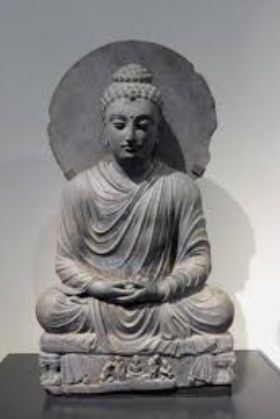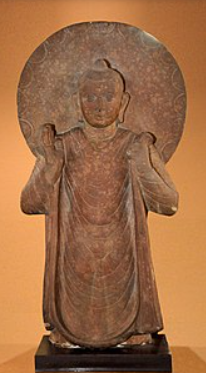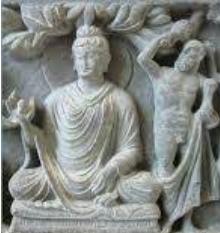
Gandhara, Mathura, and Amravati Schools: In the post-Mauryan period , the Gandhara, Mathura, and Amaravati schools emerged as significant centers for Buddhist art in India. While the Buddhist element was common to all three schools, they differed in various aspects such as the use of stone.
Gandhara, Mathura, and Amaravati schools emerged during the Kushana and Satavahana periods, each showcasing unique characteristics that contribute to our understanding of India's ancient artistic heritage. Keep reading to learn more about Gandhara, Mathura, and Amaravati schools and the key differences between them.Gandhara School of Art
 The Gandhara School of Art developed under the Kushan dynasty , with its stronghold in the northwestern region of ancient India, around modern-day Afghanistan and Pakistan. Its art form is known for its Greco-Roman influence. The key features of Gandhara art are:
The Gandhara School of Art developed under the Kushan dynasty , with its stronghold in the northwestern region of ancient India, around modern-day Afghanistan and Pakistan. Its art form is known for its Greco-Roman influence. The key features of Gandhara art are:
- Base Material: Gandhara Art originally used metamorphic rock and grey sandstone for sculptures. Later, artists shifted to stucco, which is easy to shape, and the sculptures were often painted and covered in gold.
- Greco-Roman Influence: The most distinctive feature of Gandhara art is its Greco-Roman style. The figures of Buddha and Bodhisattvas resemble the Greek god Apollo, with curly hair, draped garments, and muscular physiques.
- Realism: The Gandhara School uses high relief to show realistic scenes from Buddha's life, making the figures look lifelike. In Gandhara art, sculptures have highly detailed facial features, intricate folds in the clothing, and a sense of naturalism.
- Buddha Iconography : The Gandhara School is credited with introducing the anthropomorphic image of Buddha. The Buddha in Gandhara art is depicted in seated and standing postures, often with a calm, meditative expression and a halo behind the head, symbolizing divinity.
Mathura School of Art
 The Mathura School of Art developed around the same period as Gandhara , flourishing in the Mathura region, a significant city in northern India. Unlike the Greco-Roman influence seen in Gandhara, the Mathura School exhibits a purely indigenous style. Here are the key features of Mathura school:
The Mathura School of Art developed around the same period as Gandhara , flourishing in the Mathura region, a significant city in northern India. Unlike the Greco-Roman influence seen in Gandhara, the Mathura School exhibits a purely indigenous style. Here are the key features of Mathura school:
- Indian Elements: The Mathura School is deeply rooted in Indian traditions. The sculptures from this school depict other Indian religions such as Brahmanism and Jainism apart from Buddhism. The Mathura style evolved with a native spirit, emphasizing cultural elements unique to India.
- Red Sandstone : Most sculptures from Mathura were carved out of red sandstone, giving them a distinctive appearance. The smooth, rounded features, often radiating a sense of peace and inner calm, are hallmarks of Mathura art.
- Naturalistic Features : Mathura art favors naturalistic rather than strictly realistic features, drawing inspiration from the ideal yogi type, such as the lotus feet and meditative gaze.
- Buddha Representation: Buddha figures in Mathura art are generally more idealistic, focusing on divine aspects with a simple drape over the body, naturalistic hair, and a serene smile.
Amravati School of Art
 The Amaravati School of Art developed in the Andhra region of South India under the Satavahana dynasty . It gained prominence from around the 2nd century BCE to the 3rd century CE and is celebrated for its intricate carvings and depiction of life events from the Buddha’s life. Key features of Amaravati art are:
The Amaravati School of Art developed in the Andhra region of South India under the Satavahana dynasty . It gained prominence from around the 2nd century BCE to the 3rd century CE and is celebrated for its intricate carvings and depiction of life events from the Buddha’s life. Key features of Amaravati art are:
- White Limestone : Unlike the red sandstone of Mathura, Amaravati artists used white limestone, which gave their sculptures a delicate, refined look, often creating an illusion of marble.
- Narrative Reliefs: Amaravati art is known for its narrative relief panels that depict scenes from Buddha's life or Jataka tales, such as his birth, enlightenment, and death. These sculptures are notable for their detailed, animated style, full of life and movement.
- Graceful Depictions: Amaravati sculptures are recognized for their elegance, with dancers, musicians, and animals frequently depicted in fluid, graceful motions.
- Complex Symbolism: Similar to other schools, Amaravati embraced Buddhist themes, often using symbolism, such as the lotus flower, chakras, and stupas, which held deep spiritual meanings.
Differences Between Gandhara Mathura and Amaravati Schools
While all three schools contributed to Buddhist art, each evolved under different geographical, cultural, and historical influences. Here’s a comparison of these schools:| Differences Between Gandhara Mathura and Amaravati Schools | |||
| Feature | Gandhara School | Mathura School | Amaravati School |
| Geographical Origin | Northwestern India (Afghanistan, Pakistan) | Central India, primarily in Mathura | Southern India, especially in the Amaravati region |
| Patronage | Kushana | Kushana | Satavahanas |
| Time Period | 1st century BCE to 5th century CE | 1st century BCE to 5th century CE | 2nd century BCE to 3rd century CE |
| Key Material | Bluish-grey and Grey sandstone. | Red mottled sandstone | White marble |
| Artistic Style | Combines Greek elements with Indian themes | Indigenous style; characterized by round faces and broader features | Dynamic compositions, fluid lines, and a sense of movement |
| Buddha Representation | Seated and standing Buddha with intricate drapery | Often depicted standing, with simpler drapery | Less focus on individual features, Depicted in narrative scenes |
| Iconography | Incorporates Greek motifs, such as curly hair and drapery | Traditional Indian iconography with more emphasis on symbolism | Rich narrative imagery with stories from the Buddha's life |
| Cultural Influence | Strong Hellenistic influence | Reflects a blend of local Hindu and Jain traditions and Buddhist elements | Shows influence of both Buddhist and local artistic traditions |
| Significant Features | Realistic anatomical accuracy, spatial depth | Stylized forms, symbolic representation of divinities | Use of overlapping figures, varied postures, and dramatic scenes |
| Examples | Bamiyan Buddha statues | Buddha seated in Padmasana surrounded by two Bodhisattvas, Mathura | Great Stupa at Amaravati |
| UPSC Related Articles | ||
| UPSC Prelims Questions | NCERT for UPSC Exam 2025 | UPSC Mains Admit Card |
| UPSC Mains Exam Pattern | UPSC Scholarship Test | Nuclear Power Plants In India |
Gandhara, Mathura, and Amaravati Schools FAQs
Que 1. What are the main features of the Gandhara school?
The Gandhara School features Greco-Roman influences, realistic details, and the early depiction of Buddha as a human. It mainly used bluish-grey and grey sandstone, with intricate clothing styles.
Que 2. What material was commonly used in the Mathura School of Art?
Mathura sculptures were mainly made from red sandstone, giving them a distinct reddish color.
Que 3. How does the Amaravati School differ from the others?
The Amaravati School is known for its use of white limestone, which makes sculptures look delicate, and for its detailed reliefs showing stories from Buddha's life.
Que 4. What is the difference between the Gandhara and Mathura Schools of Art?
The Gandhara School mixes Greek styles with Indian themes and focuses on realism, while the Mathura School has a more traditional Indian style with smoother features.
Que 5. What is the difference between the Gandhara, Mathura, and Amaravati schools?
Gandhara art includes Greco-Roman styles and uses grey sandstone, whereas the Mathura art highlights Indian traditions with red sandstone. On the other hand, Amaravati art is recognized for its white limestone and dynamic reliefs that tell stories about Buddha.
Talk to a counsellorHave doubts? Our support team will be happy to assist you!

Check out these Related Articles
Free Learning Resources
PW Books
Notes (Class 10-12)
PW Study Materials
Notes (Class 6-9)
Ncert Solutions
Govt Exams
Class 6th to 12th Online Courses
Govt Job Exams Courses
UPSC Coaching
Defence Exam Coaching
Gate Exam Coaching
Other Exams
Know about Physics Wallah
Physics Wallah is an Indian edtech platform that provides accessible & comprehensive learning experiences to students from Class 6th to postgraduate level. We also provide extensive NCERT solutions, sample paper, NEET, JEE Mains, BITSAT previous year papers & more such resources to students. Physics Wallah also caters to over 3.5 million registered students and over 78 lakh+ Youtube subscribers with 4.8 rating on its app.
We Stand Out because
We provide students with intensive courses with India’s qualified & experienced faculties & mentors. PW strives to make the learning experience comprehensive and accessible for students of all sections of society. We believe in empowering every single student who couldn't dream of a good career in engineering and medical field earlier.
Our Key Focus Areas
Physics Wallah's main focus is to make the learning experience as economical as possible for all students. With our affordable courses like Lakshya, Udaan and Arjuna and many others, we have been able to provide a platform for lakhs of aspirants. From providing Chemistry, Maths, Physics formula to giving e-books of eminent authors like RD Sharma, RS Aggarwal and Lakhmir Singh, PW focuses on every single student's need for preparation.
What Makes Us Different
Physics Wallah strives to develop a comprehensive pedagogical structure for students, where they get a state-of-the-art learning experience with study material and resources. Apart from catering students preparing for JEE Mains and NEET, PW also provides study material for each state board like Uttar Pradesh, Bihar, and others
Copyright © 2025 Physicswallah Limited All rights reserved.
Get App








